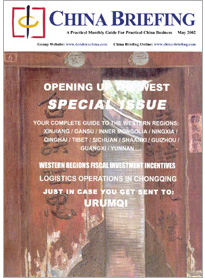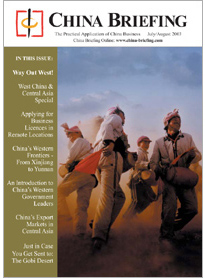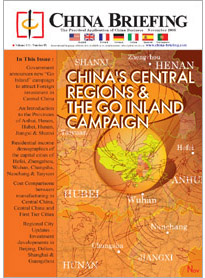Going West…
April 7 – Investing in China’s Western regions has long been a favorite topic of China Briefing – the magazine released its first overview of them way back in 2002 in an out-of-print issue that we have resurrected for you. The region was subsequently covered by us again in 2003 and we also produced a financial comparison, again in the magazine, about investing in China’s central and western regions some 18 months ago (click on the relevant cover to download the issue).
Foreign businesses in the Western regions, as the Senior Partner of Dezan Shira & Associates, Chris Devonshire-Ellis advises, have all been centered on the local market, and with just a few exceptions, not for export at this stage of the regions development.
“Dezan Shira & Associates has long had an interest in the West, and we service quite a large FDI client base throughout the area. We have always employed a Uyghur speaking lawyer on our staff, and certainly in Xinjiang Province this can help. The nature of foreign investment in the region has largely been to service the local market however. These have ranged from companies such as NEG Micon, the Danish wind power manufacturer now part of Vestas, with whom we assisted with their JV and restructuring in Inner Mongolia. That wind farm now produces electricity for the local government, part of which they sell off to other provinces. GE also have similar projects in Xinjiang. The wind farm you can see on the road from Urumqi to Turpan is theirs. Other examples include the provision of large agricultural tractors from a Finnish client to the government of Xinjiang. The province is a huge agricultural area with massive farming conglomerates covering thousands of acres. These were shipped, in parts, into Tianjin, then assembled, and transported to Xinjiang in several locations. About 400 heavy duty tractors from our client are now operational in the province. Additionally, one of the largest FDI in Ningxia is a massive redevelopment of the city of Yinchuan, with a South African client of ours building the new CBD. It includes a lake, villas, housing and commercial property and is about 50% of the way through completion – a US$1 billion total joint venture investment by the time it is completed. On the other hand, there are smaller investors, such as our Italian client in Urumqi who grows tomatoes – Xinjiang can produce up to three crops a year – and who exports them to Kazakhstan as tomato paste.
“The dynamics change in the farthest parts of West China. You have different markets to consider for export, and traders in Fubar, the only Western bar in Urumqi and run by another of our clients, will come in with tales of trips they have been making to Kazakhstan, Pakistan, even Afghanistan, to sell or buy products. Usually however, most investments are bigger ticket, aligned with development, and are usually joint ventures with government. We find that the old entry method of getting in a Chinese partner to assist with local market considerations is still valid in the West, they can provide a lot of on-the-ground expertise that a new to the region business will almost certainly need to plug into, if not for experience in dealing with the local market then certainly for smoothing passage. It’s the same as eastern China was about 15 years ago; JVs help a lot.
“Further inland, say for example Chongqing, we found that the infrastructure in getting product out of the city, and also from similar cities such as Changsha and Wuhan, to the coast for export, was largely underdeveloped or running at over capacity, meaning highly expensive, and again subject to huge protectionism. It simply doesn’t at this stage make economic sense to invest in a factory in these areas for export of product. They are still very much for the sale of product onto the domestic market, and again, protectionism still exists. It may well be better to go with a local JV partner with existing supply chain and branding assets than to try to go it alone. Selling to local domestic markets where protectionism is still strongly part of the regional business mindset is hugely problematic – you need local help to succeed. Bo Xilai’s position as Party Secretary of Chongqing will help loosen up these constraints, but this will take time. Kunming however in the Southwest, and to a large extent also Nanning, are developing very well as export led cities, Kunming is a major international export market to flowers, and Nanning is the final destination of an Asian rail network that extends throughout most of Indochina, linking China to Vietnam and Thailand and Malaysia with Singapore. Foreign investors are increasingly interested in these cities and the proposed North Vietnam – Yunnan free trade zone will further link trade between Hanoi, Kunming and Nanning. Those are areas to watch.”
Recent investment commentary on Central and West China
Commentary concerning the Investment Environment in the Central and Western cities of Changsha, Wuhan, Guiyang, Nanning, Hohhot, Xining and Lanzhou can be found in the 3TC section of past issues of China Briefing magazine. Please here to access the archives section.
Further commentary of China’s Central and Western regions may be found in the Central and West China pages of the China Briefing news section, or by using the search facility and typing in your key words.
Related articles
Used FDI in China’s western regions increases
Greater Mekong Summit concludes – China to invest millions in aid
New railways to link Xinjiang to Central Asia
Hong Kong moves towards provision of Islamic financial services
China lays its stake on Central Asia
China opens up its borders to Vietnam
China eyes stable Afghanistan as key to regional development
Xinjiang to become China’s top oil producer
- Previous Article Used FDI in China’s western regions increases
- Next Article China, India seal joint tourism offices












